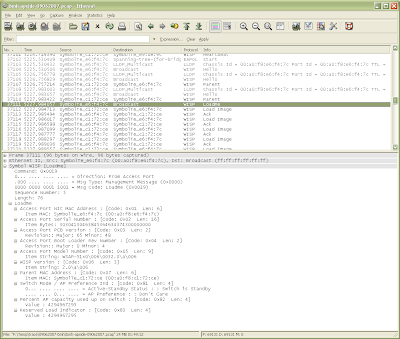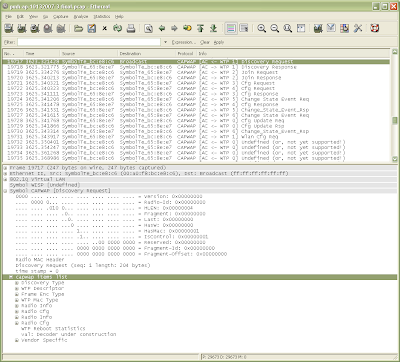[ad name=”ad-articlebodysq”]In this post I’ll review how you can find a specific wireless device on your Motorola WS5100 Wireless LAN Switch. We’re going to use the poor mans “locationing” as opposed to the features and integration that Motorola is currently building into the WS5100 and RFS7000 switches to support products such as AeroScout.
We want to locate the following device wireless-laptop.acme.org so we need to start by identifying the IP address of the device. Thanks to Dynamic DNS we can be assured that our DNS servers will have that information.
C:\> nslookup wireless-laptop.acme.org. Server: 10.1.1.1 Address: 10.1.1.1#53 Name: wireless-laptop.acme.org Address: 10.1.195.55
In most circumstances we’d now need to identify the MAC address of the wireless device. We can skip that step since the WS5100 will have the IP address of the client for us to search against.
WS5100# show wireless mobile-unit Number of mobile-units associated: 23 index MAC-address radio type wlan vlan/tunnel ready IP-address last active 1 00-1B-77-30-DF-80 30 11a 1 vlan 18 Y 10.1.195.57 1 Sec 2 00-20-E0-1A-0F-E5 58 11a 1 vlan 18 Y 10.1.195.48 20 Sec 3 00-13-E8-86-DF-F3 30 11a 1 vlan 18 Y 10.1.195.96 0 Sec 4 00-15-00-32-8C-EC 19 11a 1 vlan 18 Y 10.1.195.31 31 Sec 5 00-15-00-32-D6-46 29 11a 1 vlan 18 Y 10.1.195.50 16 Sec 6 00-15-00-32-D3-67 1 11g 2 vlan 17 Y 10.1.194.54 4 Sec 7 00-A0-F8-D4-46-9C 2 11b 4 vlan 22 Y 10.1.206.53 223 Sec 8 00-A0-F8-D4-48-FD 1 11b 4 vlan 22 Y 10.1.206.207 215 Sec 9 00-1B-77-2A-99-05 30 11a 1 vlan 18 Y 10.1.195.55 7 Sec 10 00-18-DE-7A-76-D0 30 11a 1 vlan 18 Y 10.1.195.67 16 Sec 11 00-16-6F-1D-F1-B9 1 11g 2 vlan 17 Y 10.1.194.44 6 Sec 12 00-1B-77-31-11-77 30 11a 1 vlan 18 Y 10.1.195.68 4 Sec 13 00-90-7A-04-16-5F 1 11b 3 vlan 21 Y 10.1.198.52 11 Sec 14 00-A0-F8-D6-3C-2A 1 11b 4 vlan 22 Y 10.1.206.70 652 Sec 15 00-A0-F8-D4-45-A5 2 11b 4 vlan 22 Y 10.1.206.252 170 Sec 16 00-13-E8-5B-ED-73 30 11a 1 vlan 18 Y 10.1.195.106 4 Sec 17 00-13-E8-5B-EE-39 30 11a 1 vlan 18 Y 10.1.195.111 23 Sec 18 00-18-DE-7A-9E-3A 30 11a 1 vlan 18 Y 10.1.195.77 20 Sec 20 00-90-7A-03-5E-C7 1 11b 3 vlan 21 Y 10.1.198.50 23 Sec 21 00-13-E8-86-C8-55 30 11a 1 vlan 18 Y 10.1.195.107 5 Sec 22 00-A0-F8-D4-48-5F 1 11b 4 vlan 22 Y 10.1.206.145 124 Sec 24 00-13-E8-86-C7-E7 30 11a 1 vlan 18 Y 10.1.195.110 10 Sec 26 00-1B-77-2A-5C-6C 30 11a 1 vlan 18 Y 10.1.195.81 37 Sec
Note: if you have a lot of mobile units you can use grep;
WS5100# show wireless mobile-unit | grep "10.1.195.55" 9 00-1B-77-2A-99-05 30 11a 1 vlan 18 Y 10.1.195.55 7 Sec
Now that we have the MU (Mobile Unit) index (the first number on the line) we can get the full details;
WS5100# show wireless mobile-unit 9 MAC: 00-1B-77-2A-99-05, IP Address: 10.1.195.55, Type: 11a, State: data-ready Radio Config Index: 30, Bssid: 00-15-70-12-1D-78 Wlan: 1, Vlan: vlan 18, Voice: N, Powersave: N, Classification: normal Encryption Type: tkip (key index: 1) Authentication Type: eap Last Assoc: 7990 seconds ago, Last Activity: 23 seconds ago, Roam-Count: 18 DHCP state : DHCPNONE AP Scan Support: N Session Timeout: 100 days 00:00:00 Idle Timeout: 0 days 00:30:00
In the information above we can see that the MU is associated to radio 30, so let’s look at radio 30;
WS5100# show wireless radio 30 Radio: 30, Mac: <00-15-70-11-34-32>, Type: 11a, ap Index: 7, vlan 198 Current Channel: 36 [5180 MHz], Configured Channel: acs Current Power: 17 dBm, Max ESS: 16, Max BSS: 4, Num Mu: 11 BSS: 00-15-70-12-1D-78, State: normal Current Data-Rates/Speed: basic6 9 basic12 18 basic24 36 48 54 Last Adoption: 0 days 20:55:16 ago Configuration: Adoption-pref-id: 0 Max-mobile-unit: 256, Detector: N, On-channel-scan: N WLAN-BSS mapping: [BSS 1]: 1 RTS-thres: 2346 bytes, Beacon-intvl: 100 K-uSec Dtim-count: [BSS 1]: 10 beacons Dtim-count: [BSS 2]: 10 beacons Dtim-count: [BSS 3]: 10 beacons Dtim-count: [BSS 4]: 10 beacons CCA level: 1, CCA Mode: 1, mobile-unit power: 0 dBm Short-Preamble: disabled, Antenna-Mode: diversity (both antennas) Placement: indoor, Channel-Mode: acs, Power: 20 dBm Data-Rates/Speed: basic6 9 basic12 18 basic24 36 48 54 WMM [best-effort]: aifsn: 3 txop-limit: 0 cwmin: 4 cwmax: 6 admission-control: disabled, max-mobile-unit: 32 WMM [background]: aifsn: 7 txop-limit: 0 cwmin: 4 cwmax: 10 admission-control: disabled, max-mobile-unit: 32 WMM
: aifsn: 1 txop-limit: 94 cwmin: 3 cwmax: 4 admission-control: disabled, max-mobile-unit: 32 WMM [voice]: aifsn: 1 txop-limit: 47 cwmin: 2 cwmax: 3 admission-control: disabled, max-mobile-unit: 32
It doesn’t look like the Motorola switch shows us the radio description above so we’ll need to use another command to get the description;
WS5100# show wireless radio config 30
Radio: 30, Description: Main Building Lobby, MAC: 00-15-70-11-34-32
Radio Type: 11a, AP Type: ap300
Adoption-pref-id: 0
Max-mobile-unit: 256, Detector: N, On-channel-scan: N
WLAN-BSS mapping: [BSS 1]: 1
RTS-thres: 2346 bytes, Beacon-intvl: 100 K-uSec
Dtim-count: [BSS 1]: 10 beacons
Dtim-count: [BSS 2]: 10 beacons
Dtim-count: [BSS 3]: 10 beacons
Dtim-count: [BSS 4]: 10 beacons
CCA level: 1, CCA Mode: 1, mobile-unit power: 0 dBm
Short-Preamble: disabled, Antenna-Mode: diversity (both antennas)
Placement: indoor, Channel-Mode: acs, Power: 20 dBm
Data-Rates/Speed: basic6 9 basic12 18 basic24 36 48 54
WMM [best-effort]: aifsn: 3 txop-limit: 0 cwmin: 4 cwmax: 6
admission-control: disabled, max-mobile-unit: 32
WMM [background]: aifsn: 7 txop-limit: 0 cwmin: 4 cwmax: 10
admission-control: disabled, max-mobile-unit: 32
WMM
: aifsn: 1 txop-limit: 94 cwmin: 3 cwmax: 4 admission-control: disabled, max-mobile-unit: 32 WMM [voice]: aifsn: 1 txop-limit: 47 cwmin: 2 cwmax: 3 admission-control: disabled, max-mobile-unit: 32
So it looks like the device we’re looking for, wireless-laptop.acme.org (10.1.193.55), is connected to radio 30 (802.11a) which has a description of “Main Building Lobby”. While this will give you an idea of the basic location it doesn’t provide you a specific location. While there are new APIs in the WS5100 and RFS7000 that can provide locationing by means of triangulation between multiple Access Ports, they require external applications and management software.
Obviously you’ll need to make sure that you’ve put descriptive locations on each radio (AP300) through the Motorola console when configuring/installing the APs.
Cheers!








